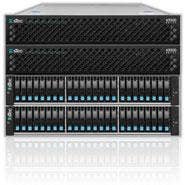TechEd News: sTec Intros All-SSD Storage Appliance With Windows Storage Server 2012

SSD manufacturer sTec on Monday unveiled an all-SSD appliance based on industry-standard components and Microsoft's Windows Storage Server 2012 operating system.
The sTec s3000 storage appliance, unveiled at this week's Microsoft TechEd conference, is a storage appliance based on the needs of customers in such areas as oil and gas, Federal government, financial, telco, and Web 2.0 companies that depend on high-performance applications, said Ali Zadeh, chief marketing officer for Santa Ana, Calif.-based sTec, which this year has been shifting focus from OEM sales to the channel.
Among those applications are transitional databases, server virtualization, the cloud, virtual desktop infrastructure, business intelligence and high-performance computing, Zadeh said.
[Related: SSD Shipments To Double This Year, Hit 40 Percent Of Hard Drive Market By 2016 ]
Meeting these requirements is the goal of the sTec s3000 all-SSD appliance.
"It's a solid-state unified storage platform based on Windows Storage Server 2012," he said. "Our goal is to use commodity hardware with the Windows operating system and our own solid-state storage to create an award-winning solution."
Dennis Mueller, vice president of innovation and emerging technologies at CMT, a Santa Clara, Calif.-based solution provider, said it will be interesting to see where the sTec s3000 gains traction in the face of all the potential competition.
"I could see that fitting in smaller companies, or in pure Microsoft shops," Mueller said. "But it's hard to imagine someone choosing it over a lower-end NetApp box, or over more established SSD storage companies like Pure Storage."
The advantage of Windows Storage Server 2012 as an operating system for an all-SSD appliance comes into play in all-Microsoft shops, Mueller said. "It lets customers take advantage of their Microsoft tools," he said.
However, Mueller said, there could be issues if it is not properly managed.
"Every week, we install Windows patches," he said. "With NetApp, we patch maybe once a year. And, it's not even necessary to do that sometimes. And with clustering, NetApp solutions have no downtime. You can do failovers and upgrades in real time."
Zadeh said the Windows Storage Server 2012 operating system is ideal for businesses looking to deliver both block- and file-based storage services.
"Who has the best unified storage solution?" he said. "Microsoft. Microsoft created the file-based environment and has now added dedupe and other enterprise features."
NEXT: High Availability And Scalability With The sTec s3000
The sTec s3000 comes in a minimum high-availability configuration of two storage heads and two storage shelves, said Zack Mihalis, sTec's vice president of product management and marketing.
Each head includes two 8-core Intel Xeon E5-2680 processors, 128 GB of memory, dual-mirrored boot drives, four Gbit Ethernet ports and up to six 10-GbE ports. Each shelf includes eight to 48 SSDs for a total capacity of up to 96 TB of SSD storage per node.
The sTec s3000 scales to up to eight nodes. Mihalis said.
The initial configuration of two head units and two storage shelves provides an optimized high-availability solution, he said. "It's the optimal configuration for performance, with no bottlenecks," he said. "And it's optimized for reliability. You can go to up to eight of these nodes. But, some customers might start with one head and one shelf with a minimum of eight SSDs."
sTec's Zadeh said the limit of 48 SSDs per node has to do with ensuring maximum performance.
"When you get over 48 SSDs, the bottleneck becomes the compute head and the backplane of the system," he said. "And you can add more shelves to a head, but you just get more capacity, not necessarily more performance."
With 48 SSDs in a shelf, the sTec s3000 offers 340,000 4k-random-read IOPS and 290,000 4k-random-write IOPS in an iSCSI configuration, or 1.2 million 4k-random-read IOPs and 600,000 4k-random-write IOPS in as SMB3.0 (server message block) configuration, Zadeh said.
"These numbers are not reading from cache," he said. "They're reading from the SSDs. This is four times the performance of the highest-end tier-one solutions costing $1 million and built in boxes the size of two or four refrigerators."
The sTec s3000 is available starting this week with a base price of around $70,000 for one head and eight 800-Gbyte SSDs.
PUBLISHED JUNE 3, 2013